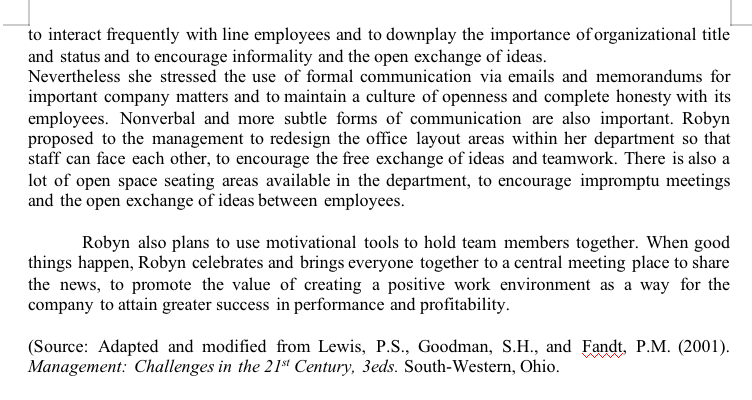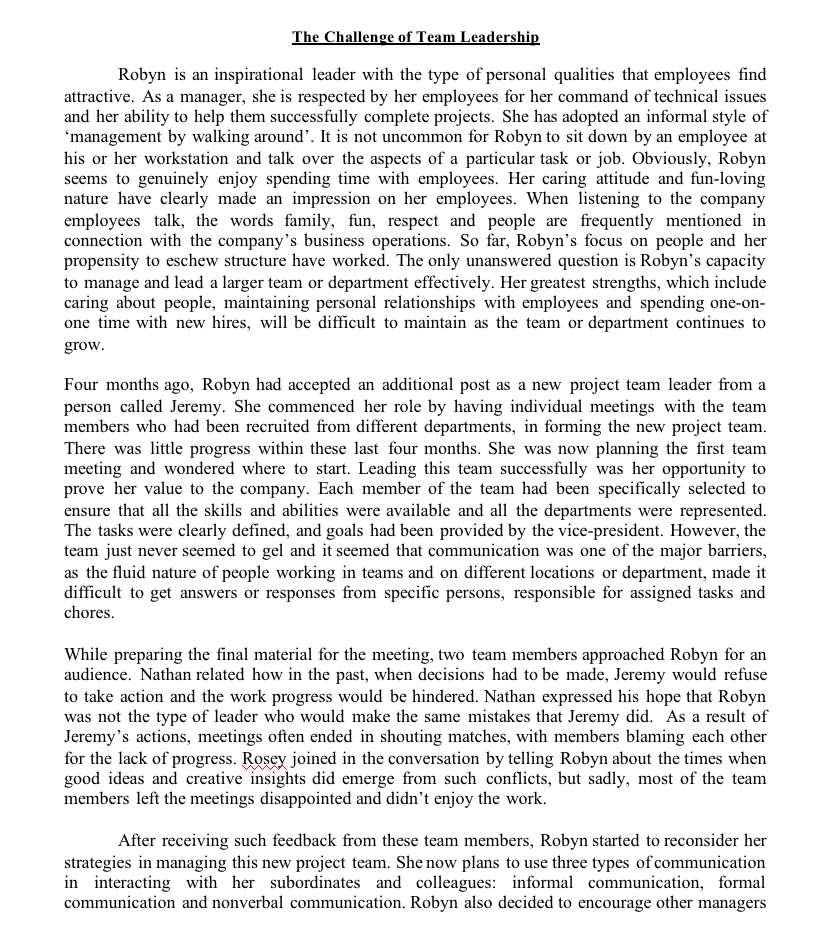Communication processes if not managed effectively, can deliver major barriers in a managing a group. Critical discuss any FIVE (5) communication barriers that could be faced by Robyn in managing the meeting with her team members. Suggest how Robyn can reduce the incidences of miscommunication and misunderstanding during team meeting, particularly in the face of high group member diversity.
Communication processes if not managed effectively, can deliver major barriers in a managing a group. Critical discuss any FIVE (5) communication barriers that could be faced by Robyn in managing the meeting with her team members. Suggest how Robyn can reduce the incidences of miscommunication and misunderstanding during team meeting, particularly in the face of high group member diversity.
Management, Loose-Leaf Version
13th Edition
ISBN:9781305969308
Author:Richard L. Daft
Publisher:Richard L. Daft
Chapter15: Leadership
Section: Chapter Questions
Problem 7EE
Related questions
Question
Communication processes if not managed effectively, can deliver major barriers in a managing a group. Critical discuss any FIVE (5) communication barriers that could be faced by Robyn in managing the meeting with her team members. Suggest how Robyn can reduce the incidences of miscommunication and misunderstanding during team meeting, particularly in the face of high group member diversity.

Transcribed Image Text:to interact frequently with line employees and to downplay the importance of organizational title
and status and to encourage informality and the open exchange of ideas.
Nevertheless she stressed the use of formal communication via emails and memorandums for
important company matters and to maintain a culture of openness and complete honesty with its
employees. Nonverbal and more subtle forms of communication are also important. Robyn
proposed to the management to redesign the office layout areas within her department so that
staff can face each other, to encourage the free exchange of ideas and teamwork. There is also a
lot of open space seating areas available in the department, to encourage impromptu meetings
and the open exchange of ideas between employees.
Robyn also plans to use motivational tools to hold team members together. When good
things happen, Robyn celebrates and brings everyone together to a central meeting place to share
the news, to promote the value of creating a positive work environment as a way for the
company to attain greater success in performance and profitability.
(Source: Adapted and modified from Lewis, P.S., Goodman, S.H., and Fandt, P.M. (2001).
Management: Challenges in the 21st Century, 3eds. South-Western, Ohio.

Transcribed Image Text:The Challenge of Team Leadership
Robyn is an inspirational leader with the type of personal qualities that employees find
attractive. As a manager, she is respected by her employees for her command of technical issues
and her ability to help them successfully complete projects. She has adopted an informal style of
'management by walking around'. It is not uncommon for Robyn to sit down by an employee at
his or her workstation and talk over the aspects of a particular task or job. Obviously, Robyn
seems to genuinely enjoy spending time with employees. Her caring attitude and fun-loving
nature have clearly made an impression on her employees. When listening to the company
employees talk, the words family, fun, respect and people are frequently mentioned in
connection with the company's business operations. So far, Robyn's focus on people and her
propensity to eschew structure have worked. The only unanswered question is Robyn's capacity
to manage and lead a larger team or department effectively. Her greatest strengths, which include
caring about people, maintaining personal relationships with employees and spending one-on-
one time with new hires, will be difficult to maintain as the team or department continues to
grow.
Four months ago, Robyn had accepted an additional post as a new project team leader from a
person called Jeremy. She commenced her role by having individual meetings with the team
members who had been recruited from different departments, in forming the new project team.
There was little progress within these last four months. She was now planning the first team
meeting and wondered where to start. Leading this team successfully was her opportunity to
prove her value to the company. Each member of the team had been specifically selected to
ensure that all the skills and abilities were available and all the departments were represented.
The tasks were clearly defined, and goals had been provided by the vice-president. However, the
team just never seemed to gel and it seemed that communication was one of the major barriers,
as the fluid nature of people working in teams and on different locations or department, made it
difficult to get answers or responses from specific persons, responsible for assigned tasks and
chores.
While preparing the final material for the meeting, two team members approached Robyn for an
audience. Nathan related how in the past, when decisions had to be made, Jeremy would refuse
to take action and the work progress would be hindered. Nathan expressed his hope that Robyn
was not the type of leader who would make the same mistakes that Jeremy did. As a result of
Jeremy's actions, meetings often ended in shouting matches, with members blaming each other
for the lack of progress. Rosey joined in the conversation by telling Robyn about the times when
good ideas and creative insights did emerge from such conflicts, but sadly, most of the team
members left the meetings disappointed and didn't enjoy the work.
After receiving such feedback from these team members, Robyn started to reconsider her
strategies in managing this new project team. She now plans to use three types of communication
in interacting with her subordinates and colleagues: informal communication, formal
communication and nonverbal communication. Robyn also decided to encourage other managers
Expert Solution
This question has been solved!
Explore an expertly crafted, step-by-step solution for a thorough understanding of key concepts.
Step by step
Solved in 2 steps

Recommended textbooks for you

Management, Loose-Leaf Version
Management
ISBN:
9781305969308
Author:
Richard L. Daft
Publisher:
South-Western College Pub

Management, Loose-Leaf Version
Management
ISBN:
9781305969308
Author:
Richard L. Daft
Publisher:
South-Western College Pub